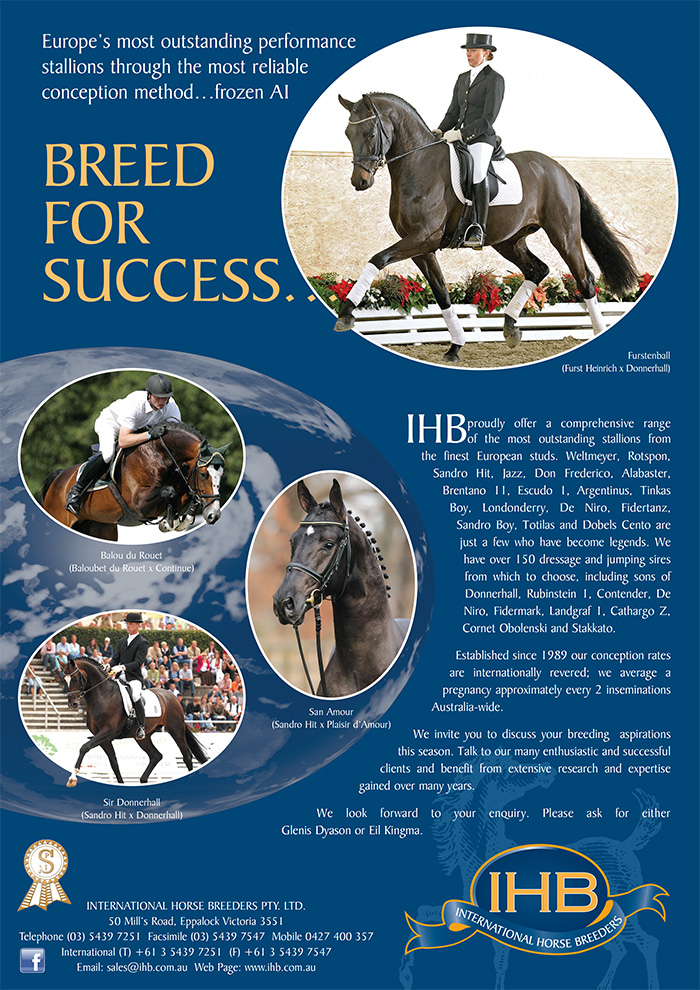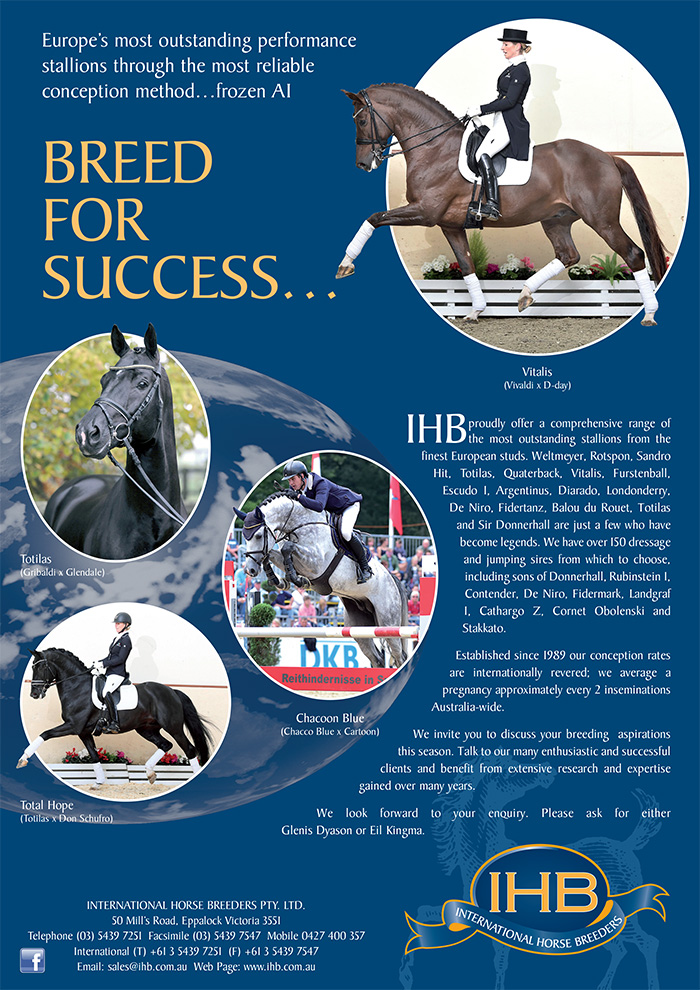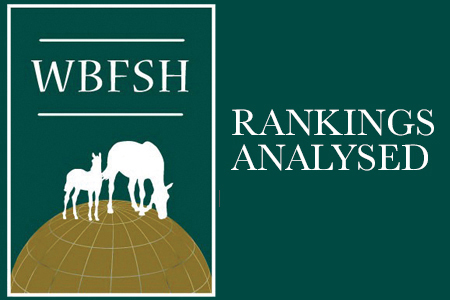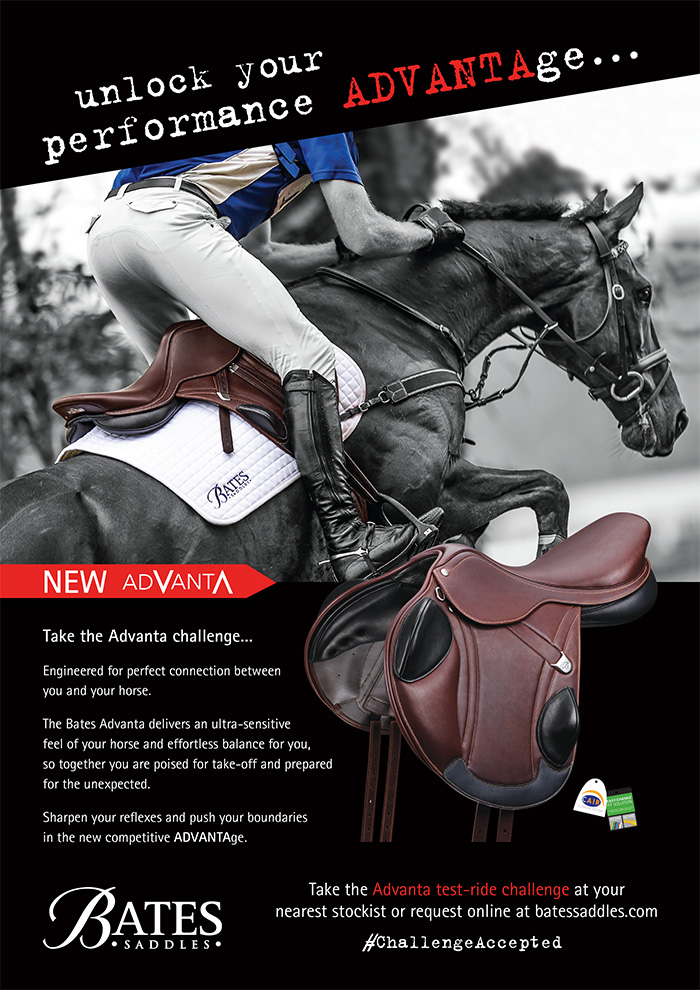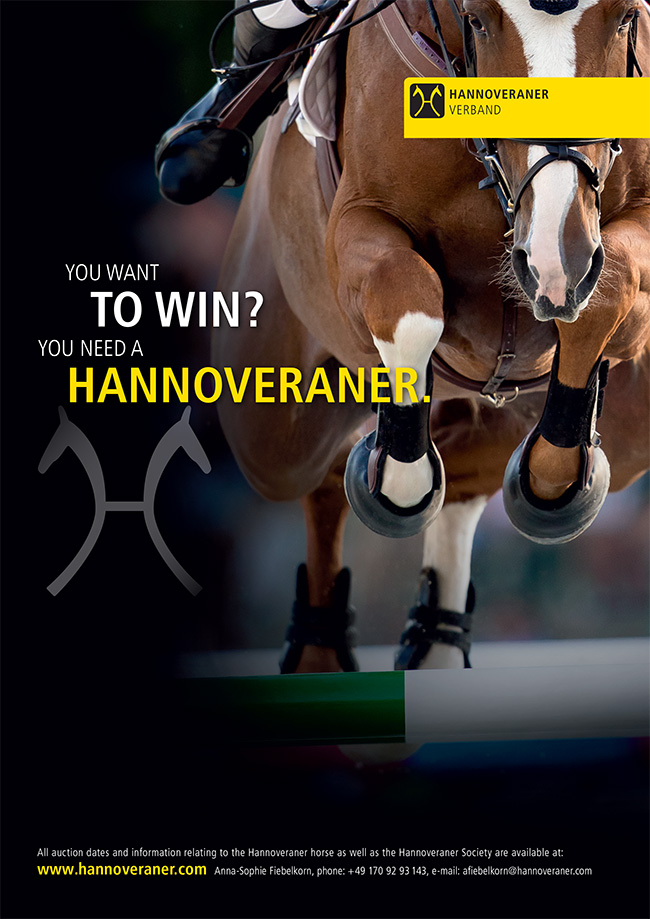Christopher Hector examines this year’s final studbook rankings,
Gemma Alexander has fun with the stats…
Leading the 2017 (it is confusing, the rankings that come out in October 2018, are called the 2017 rankings…!?) Eventing standings is Phillip Dutton’s WEG ride, Z, although Horse Telex assures me the horse’s name is Albano Z, which does seem more likely. The gelding had showjumped to 1.50 with a Portuguese rider before he went to Dutton, and the breeding is pure showjump. His Holsteiner sire Asca competed 1.60 and has a pedigree contains all the names that made Holstein famous. (Incidentally, Asca’s dad, Askari is the sire of the 2018 WEG sensation – showjumping gold medallist, DSP Alice.)
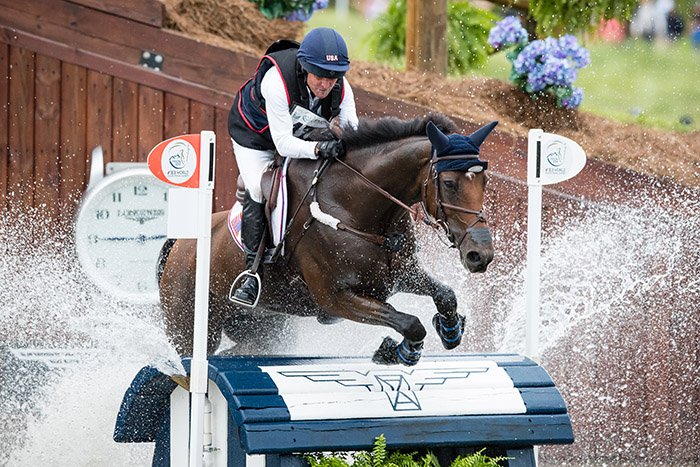
Albano Z and Phillip Dutton – world number one (Eric Knoll photo)
Albano Z’s dam Belle Bouche B is a right mix, she is by another 1.60 showjumper, Babouce VH Gehucht Z, who is by the Selle Français showjumping star, Baloubet du Rouet, out of Grace Kelly, who is registered with that ‘other’ Dutch book the Nederlands Rijpaarden en Pony Stamboek (NRPS), although both her parents were KWPN. Her sire another 1.60 jumper, N-Aldato (Nimmerdor / Ladykiller), while her dam was by influential Ramzes’ son Rigoletto.
It is perhaps some measure of where the sport is going that the leading eventer is so solidly showjumping bred, however we might note that Albano Z finished 13th at Tryon, dropping down because of 6.4 time over a course where the leading horses came home largely time fault free… maybe that’s the price you pay for all that showjumping blood?
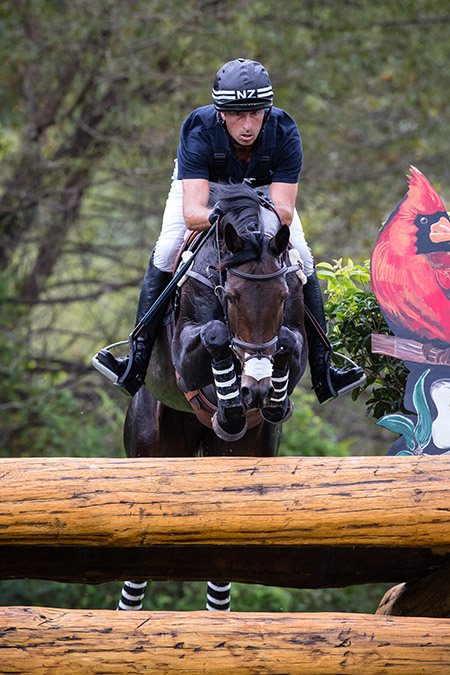
Top eventer for the KWPN – Cekatinka (Eric Knoll photo)
The leading studbook for eventing was the KWPN, and with that result the Dutch were on their way to a clean sweep of the three Olympic disciplines, although the sceptical observer might ask just how Dutch was the Dutch contingent? Their leading horse was Cekatinka, ridden into 8th at Tryon by Kiwi, Tim Price. The horse’s bloodlines are a pan-european affair, although she is very much the product of the vision of leading Dutch breeder (and long time Dutch team vet) Jan Greve. She is by the Hanoverian 1.60 showjumper, King Kolibri (who Greve brought to Holland) and out of a mare by the St. Leger winner, Julio Mariner, a stallion that was not a huge success in the UK as a sire, and was bought by Greve to put more ‘blood’ into his mare band. On the final line, we have a mix of Hanoverian and Oldenburg blood… The third and fourth members of the Dutch eventing team are by Selle Français sires.
Maybe concentrating on the blood misses the point, the Dutch were the first major studbook that was prepared to take talent from where-ever it found it, a couple of decades down the track, the open door policy is standard operating procedure for all the major books. Certainly the Irish, so long the last bastion of the closed book, have no reason to complain, their number one, Stellor Rebound is by a Dutch branded stallion of Holstein breeding, Romke. Number two, Ardagh Highlight, is the classic Irish mix of Irish Draught and Thoroughbred, while their third and fifth ranked eventers are by Courage II, a Holstein import, separated by Quarrycrest Echo, all Irish on the topline, but out of a mare by another Irish import from Holstein, Cavalier Royale.
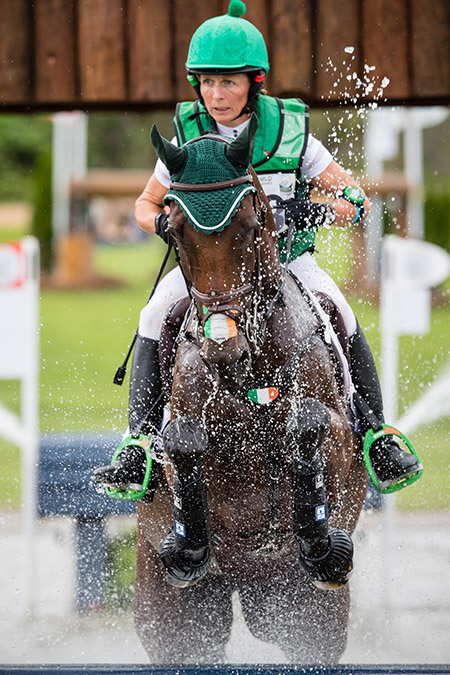
Stellor Rebound leading the Irish contingent…. (Eric Knoll photo)
Selle Français take third spot, with only one ‘foreign’ stallion, L’Arc de Triomphe (Oldenberg, Westalien, Hanoverian) in their line-up, with the French attracting more attention (and buyers) with the strong showing of the Anglo Arab book in eighth place. The star of the Anglo book was Vassily de Lassos, who missed a bronze medal by a whisker (and some ludicrous dressage judging). Vassily is by Jaguar Mail, who almost had two in the top fifty, Vassily at 10th and the Westfalien, Jum Jum in 51st. Courage II had three in the top 50, while Balou du Rouet sired two, of Balou much more when we look to the showjumping tables but first a run through the stats…
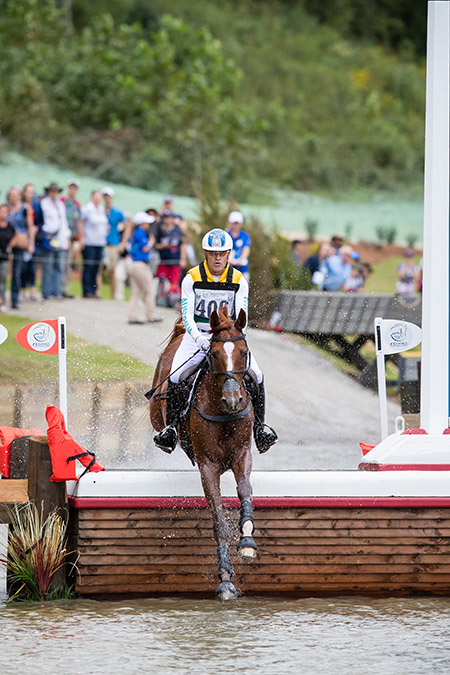
Vassily de Lassos, watch out for the Anglo Arabs… (Eric Knoll photo)
With number cruncher extraordinaire, Gemma Alexander:
Taking a deeper look at the top 10 studbooks in the eventing rankings, just how many of the listed offspring are actually of the specified breeding… with the six representatives of each studbook, only 56% of the parents of these horses were listed in the same studbook. Going back further to look at the grandparents, this falls to 37%. Interestingly, the eventers have the largest portion of ‘unknowns’ in the pedigrees of these star performers of the three disciplines.
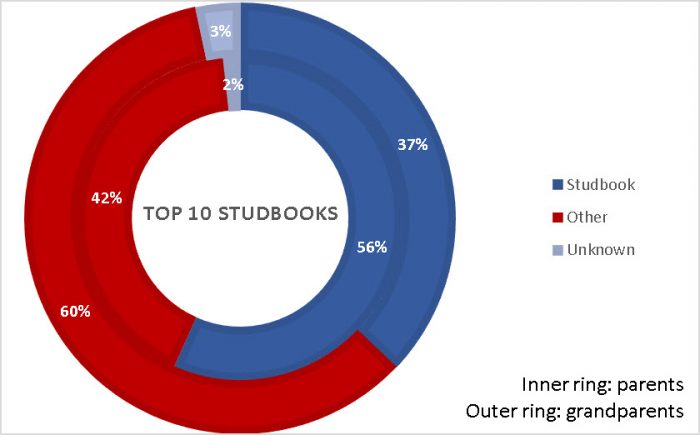
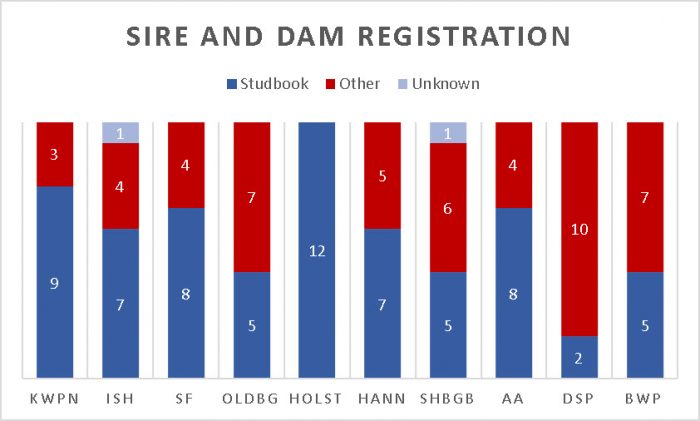
(Note – pie chart denotes percentages while bar chart shows number of horses…)
The worst offender for labelling outside blood as their own – or conversely, the studbook with the most open-book policy – was the Landesverband Bayerischer Pferdezüchter e.V., or DSP (previously known as the Bavarian studbook) which ranked 9th of the top ten studbooks for eventing. Of the top six representatives of this studbook, just two parents were also registered DSP, and NONE of the grandparents. For the eventers, the most closed studbook was the Holsteiners who came in 5th, with all parents of the top-six also being Holsteiner-branded, and 79% of the grandparents also hailing from the studbook. Both the ISH and Sport Horse Breeding of Great Britain (SHBGB) studbooks (2nd and 7th place respectively) shared the greatest number of ‘unknowns’ in the pedigrees of their top representatives, both with one parent and four grandparents each of unknown heritage. Bearing in mind that these are the very best eventers in the world, it seems quite unfathomable that there are so many blanks in the pedigrees. You certainly don’t see that happening over in the likes of Holstein… Perhaps this is telling of the fact that ‘specialised’ breeding for eventing is some years behind the showjumping and dressage world?
Which brings us to another question… if only 56% of parents and 37% of grandparents of these top-ranked eventing horses are registered in the same studbook as the offspring, which studbooks do they come from? For this exercise we just look at the top three eventing studbooks: KWPN, ISH and SF.
Starting with the KWPN:
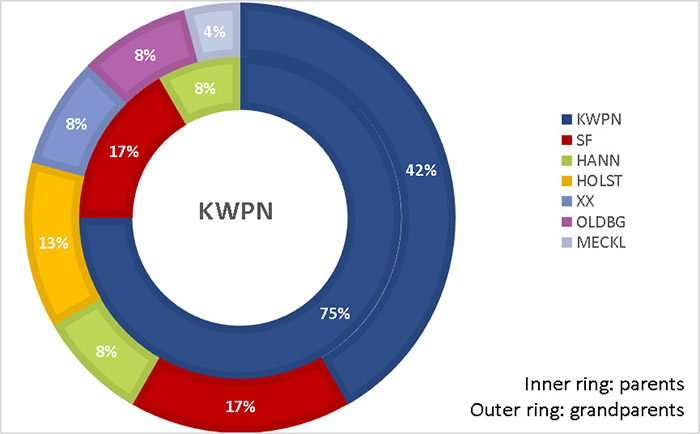
Apart from their own, the second most represented studbook in the pedigrees of the top-six KWPN representatives was SF, with 17% of both parents and grandparents branded French. Next came Hanoverians, with 8% of both parents and grandparents hailing from this studbook. Then the Holsteiners, with none in the first generation, but 13% of grandparents. Other studbooks featuring in the pedigrees of these KWPN horses were Thoroughbred, Oldenburg and Mecklenburg.
Next to the Irish Sport Horses:
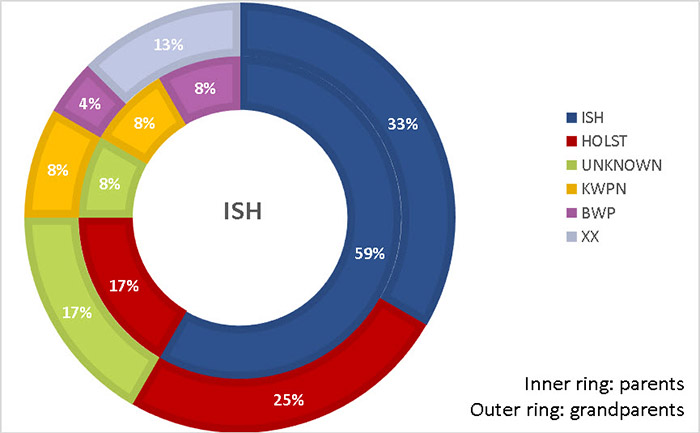
The most represented studbook in the pedigrees outside of the Irish was the Holsteiners, with 17% of parents and 25% of the grandparents registered to this society. Surprisingly, next came the ‘unknowns’, with 8% of parents and 17% of grandparents being blanks on the pedigree tree. Then came the Dutch with 8% of parents and 8% of grandparents of these horses branded KWPN. The other two studbooks that appeared in the first two generations of these pedigrees were BWP and Thoroughbred.
And finally, the French:
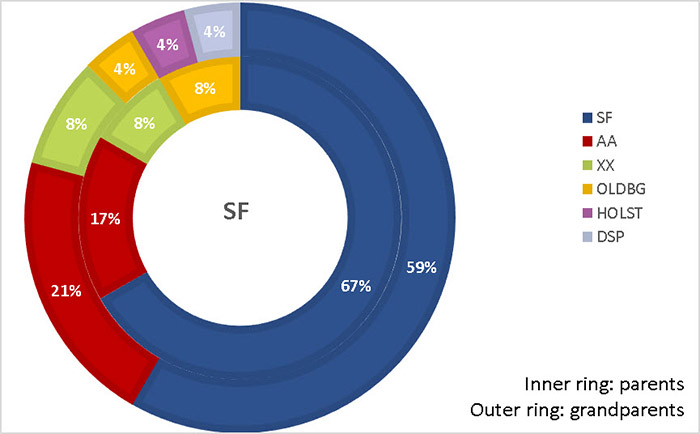
Given the strong influence of blood in the history of the breed, there is no surprise that the two most influential outside studbooks on the pedigrees of these top six Selle Français eventers were Anglo Arab (17% of parents and 21% of grandparents) and Thoroughbred (8% of both parents and grandparents). The third most represented outside studbook in these SF pedigrees was Oldenberg, with 8% of parents and 4% of grandparents hailing from this heritage. Holsteiners and DSP (previously Bavarian) were also found in the first two generations of these horses.
Thanks Gemma
Next we look at the Showjumpers
The showjumpers
The breeders’ title in the Showjumping goes to Mario and Mischa Everse, the Dutch breeders of Zinius, a winner of over half a million euros with Harrie Smolders. The pair’s biggest win in 2017 was just under €60 K in the World Cup class at Mechelen. In 2018, their biggest pay cheque was €30,690 for a win in a 1.50/1.55 class at the London 5*.
Again the KWPN brand is not obvious from the pedigree. He is by the BWP stallion, Nabab de Rêve (whose blood is entirely Selle Français) out of the BWP mare, Winia van ‘t Vennehof, who is by the KWPN stallion, Kannan, although their stallion commission failed him at the first inspection, and he had to wait until he was 19 years old to become an official KWPN breeding stallion.
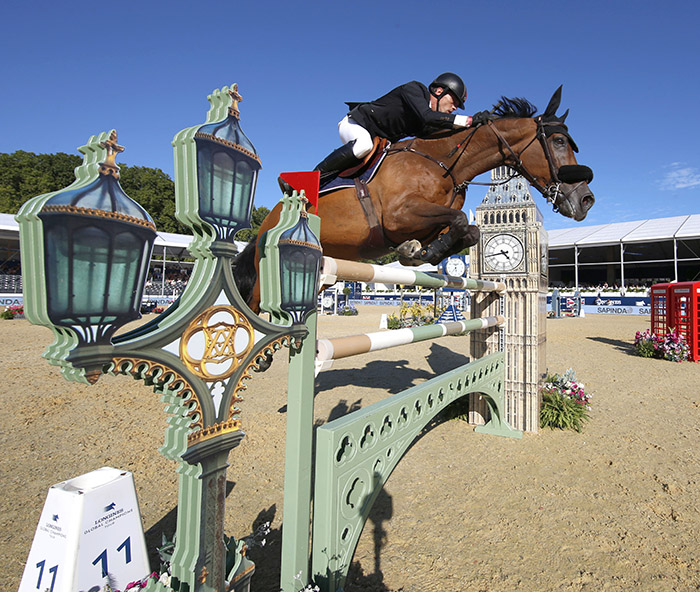
Zinius and Harrie Smolders – Photo Stefano Grasso/LGCT
Winia competed 1.40 with American Zazou Hoffman, and aside from Zinius, she foaled his two-year-older brother, Coriander van ‘t Vennehof (by Triomphe de Muze) a 1.60 competitor with Britain’s Keith Shore and Syria’s Baraa Jaboulieh.
I caught up with Mario Everse and found that he, like so many others, had caught the breeding bug as a youngster…
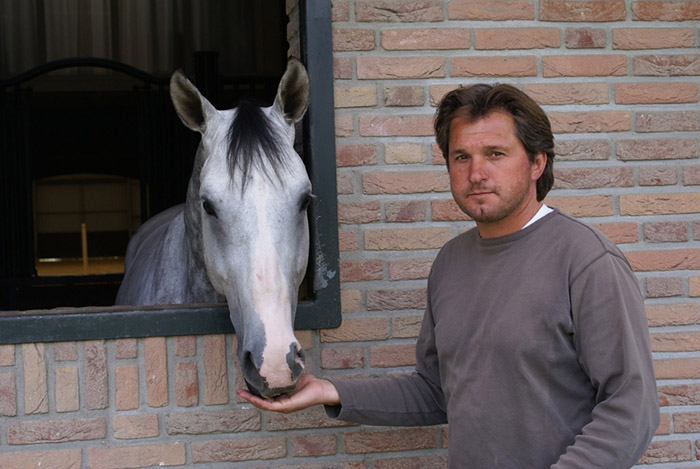
“When I was twelve, I was given by my father, a three-year-old mare – she was of good breeding, and I got interested in the breeding and from that time on, I always had a foal at home. I’m now 48, so that was a long time ago.”
But now it’s a lot more than one foal a year at Everse Horses…
“We got bigger and bigger. This year I had 37 foals. I have a very good vet, who is good with embryos.”
What stallions did you use?
“From last season I had some Kassander van ‘t Roosakker (Echo van ‘t Spieveld / Carthago), he’s quite a young stallion, only eight years old. He’s doing quite well this year with Grégory Wathelet, but I knew him when he was younger. I’m quite interested in the Belgian breeding, they have scopey horses in Belgium, and I like the Roosakker line.”
The first mare of this line, Usha van ‘t Roosakker, foaled 1997, by Chin Chin, jumped 1.50 herself, and produced two 1.60 horses, most notably Cella who starred with Ben Maher and Mario Deslauriers, while her daughters, grand-daughters, and great grand daughters, produced a swag of top jumpers.
“I also used Cellestial (Cantus / Windesi xx), he’s a bit of an older stallion, but I like good conformation in my horses. He is a bit uphill and a ‘bloody’ horse, he’s an older stallion, but actually quite modern, that’s why I use Cellestial. I bred with Vigo d’Arsouilles because he has so many good progeny, and I bred with Perigueux, because he is also uphill and light. I think lightness is important in the horses.”
Can you tell me a little about the world number one, Zinius?
“I bought the mare, Winia, when she was two or three years old. It is the line of Davinia. She had one foal and then we started riding her. When Winia was six or seven, we sold her to America where she jumped 1.45 / 1.50. She was a sharp mare and now she makes great foals.”
It must be a great honour to win the WBFSH top breeder title, what is it about breeding horses that gets you in?
“We really like the sport ourselves. We try to breed them, and educate them, until they come to the highest level. I also buy young horses, like Big Star, I bought him when he was four years old. I try to find the good ones, and when you sell them you can make money, it’s fantastic, it’s our hobby and we can live from it. It’s a nice life.”
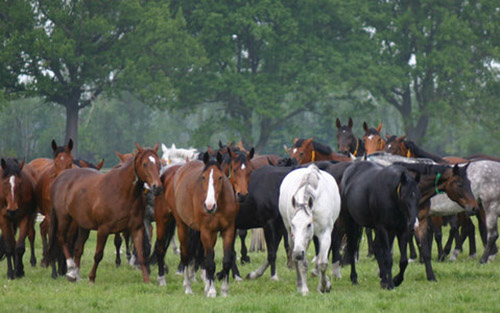
Just a few of the residents at Gestut Lewitz
Usually at this point I would identify a breeder with more than one representative in the top group and suggest that they are the one who should get the Rolex, not the lucky breeder of one exceptional horse. This time I am not sure, the only breeder with more than one in the top 40 is Paul Schockemöhle at his Gestüt Lewitz, but the sheer size of Lewitz should disqualify it from the competition – 3000 acres and accommodation for 4000 horses – and anyway I’m sure Mr Schockemöhle has more than enough watches already. Three of the four horses from Lewitz are by Schockemöhle’s outstanding stallion, Chacco-Blue.
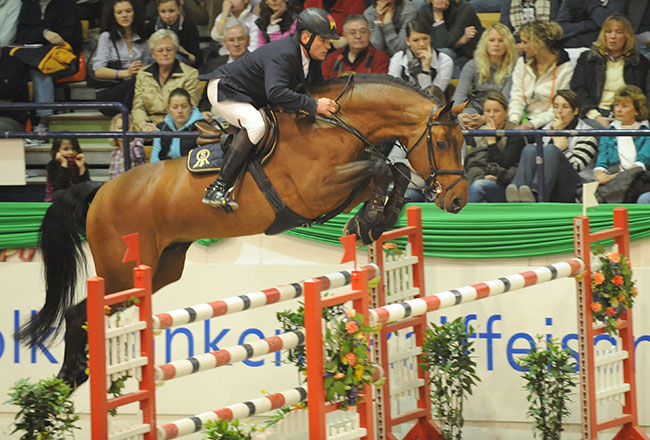
Chacco-Blue
Chacco-Blue was also the best represented stallion – with nine competitors – in Tryon. Paul Schockemöhle told me the worst thing about Chacco-Blue was that he died way too early, at the age of only 14 in 2002, the best thing was the brain he gives:“Okay he could jump, but the best thing was his mentality. He tried always, even if you rode him at a wall of two metres fifty, he couldn’t have jumped it but he would have tried, and this he gave absolutely to all his children. At the beginning they are not so fantastic jumpers but they always learn and they are really willing to learn.”
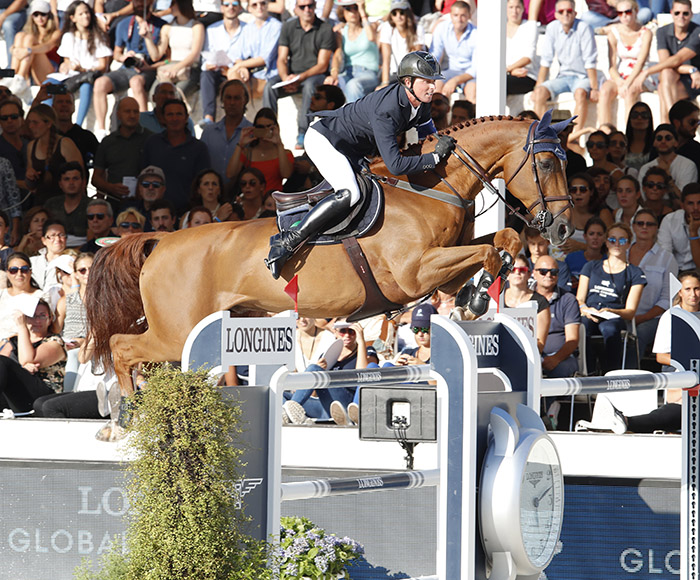
Explosion W – ranked 5th, best of the Chacco-Blue progeny
– Photo Stefano Grasso/LGCT
According to Alois Pollmann-Schweckhorst, who rode Chacco-Blue for most of his competition career, credit must also be given to Mr Schockemöhle and his breeder’s eye: “Paul Schockemöhle used him a lot because he realized very soon how to find the right mares for him. In his opinion Chacco-Blue fitted to a lot of his mares, he has around 1000 mares but he knows every brood mare by name. If you say one name of a mare, he says, yes, the grandmother of this mare, I bought from Hartwig Steenken, or Alwin Schockemöhle in 1970… She is related to this horse and this horse. That is a knowledge that no-one else has, and then it comes, maybe by intuition, that Chacco-Blue fits this mare. He has the best experience, and the best success.”

Margie Goldstein Engle and Royce
The best of the Lewitz jumpers was Margie Goldstein Engle’s Royce, in fifth place, and registered with Schockemöhle’s OS (Oldenburg Jumping) stud book, although this time the bay stallion is not by Chacco-Blue, but by Cafe au Lait, a son of Contender, out of a Diadem mare. Royce headlines the OS team in 5th place, with 3/5ths of the team by Chacco-Blue. The position of the relatively small, and relatively new studbook is all the more impressive when we consider the books below them: 6th. Swedish Warmblood, 7th. Hanoverian, 8th. Holstein, 9th. Anglo European, and 10th. Zangersheide.
Gemma decided to look closer…
When analysing the top 100 horses in the breeding rankings, and what studbooks they hail from, this observation regarding the OS and its fairly meteoric rise up the standings is backed up by the stats. Proportionally, the OS is punching well above its weight in terms of providing horses at the top of the sport. As a baseline we looked at foals born into the studbook in the years 2008 and 2009 (meaning offspring are now 9 – 10 years old and starting to make their mark on the sport). What we found was that although only roughly 3,000 foals were born into the OS in 2008 and 2009; by 2018, 10 OS horses had made it into the WBFSH Top 100 Breeders Rankings – a strike rate of 0.33%. While it does not seem like much, when compared with the much larger and more established books of the KWPN (approximately 8,000 jumper foals, 0.21% strike rate) and SF (roughly 22,400 foals, 0.04% strike rate), it becomes apparent what an achievement this is! It is all about the context!
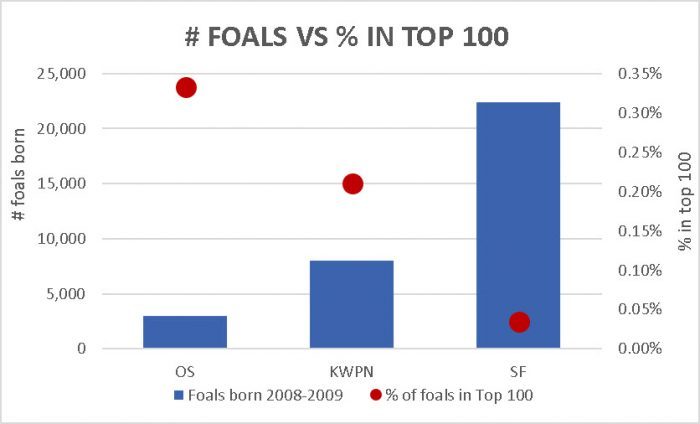
Thanks again Gemma

Best of the BWP – H&M Harley vd Bisschop – Photo Stefano Grasso/LGCT
The BWP continues to consolidate its place at the top, second this time round, with their top performer, young Nicola Phillippaerts’ grey mare, H&M Harley vd Bisschop. The pair have won almost a million euros, with wins in major 5* classes at Cascais GCT and Calgary. His sire, Dulf van den Bisschop peaked at 1.45 but his breeding is all class, Heartbreaker over a Libero mare. Harley is out of the Holsteiner mare, Charisma (Coronado / Silvester).
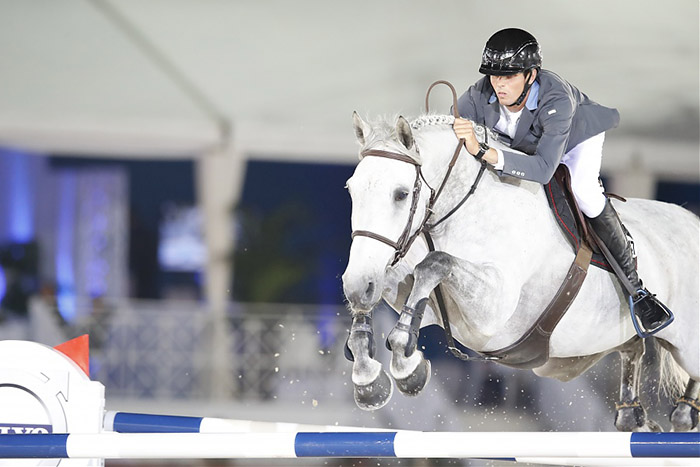
Timon d’Aure – half French, half German – Photo Stefano Grasso/LGCT
The Selle Français book is third, their team headed by Timon d’Aure, by Mylord Carthago*HN. Mylord is by Carthago, and is perhaps the best of the 50 or so foals Belgian vet and breeding whiz, Joris de Brabander has coaxed out of his star broodmare, Fragance de Chalus (Jalisco B / Fury de la Cense). Timon is out of a mare by the Narcos II son, Drakkar des Hutins.
In fourth we find Westfalia, and not surprisingly four of their team of six are by Cornet Obolensky, the Belgian colt that Westfalia adopted as their own, even if he was Ukranian owned.
Gemma is back crunching the numbers…
A deeper dive into the top 10 jumping studbooks and how closely the pedigrees match the ‘brand’ shows that 49% of the parents of the top-six representatives for each studbook also share the same registration of the competitor, and 35% of the grandparents. The showjumping studbooks also had the lowest incidence of ‘unknowns’ in the pedigrees, with all parents listed and all but two grandparents known.
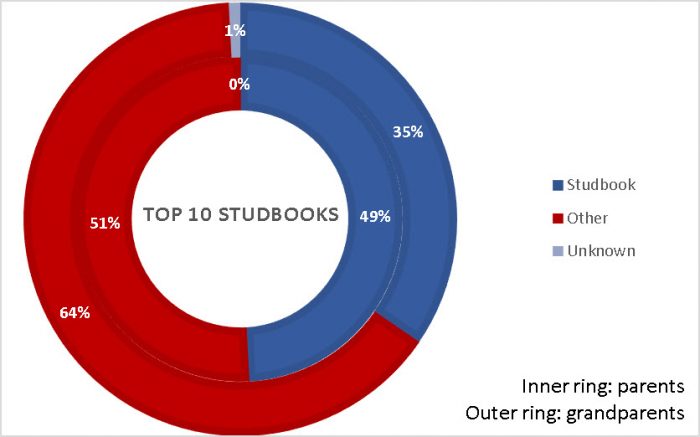
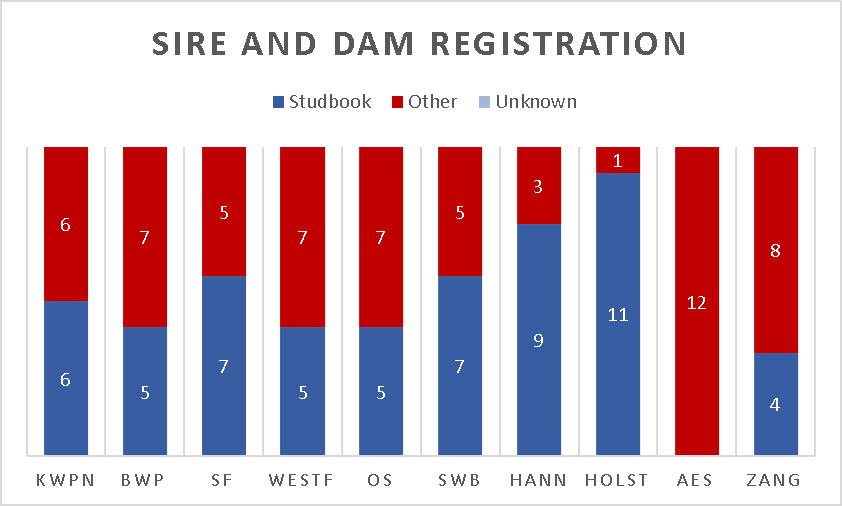
The Anglo European Studbook (AES ) which ranked 9th of the top ten jumping studbooks interestingly had NO parents and NO grandparents of their top six representatives also registered with the AES. This is likely due to the fact that the studbook is just that – a studbook for registration – as opposed to also being a recognised breed society such as the Holsteiners and Hanoverians. Registration into this studbook is more likely a result of proximity rather than pedigree, and as such does not really give us much insight into the heritage of their top performers. The AES is also the only top-ten jumping studbook to have a member of their top-six showing an ‘unknown’ – two grandparents of these competitors were of unknown heritage. Again, this comes down to this studbook being merely a means of registration, rather than an acknowledgement of generational breeding; registration is not dependent on the strength of pedigree.
Again the most ‘closed’ studbook in the top ten is the Holsteiners (8thplace), with 92% of the parents and 96% of the grandparents of the top-six representatives also being Holsteiner-branded. The Holsteiners have long prided themselves with being excellent producers of jumping horses and have only sparingly approved stallions from outside studbooks as ‘breeding experiments’, so it is perhaps no surprise that the top-six representatives of the Holsteiners are so classically ‘Holstein’.
This pie chart shows the proportion of ‘outside’ blood in the KWPN team:
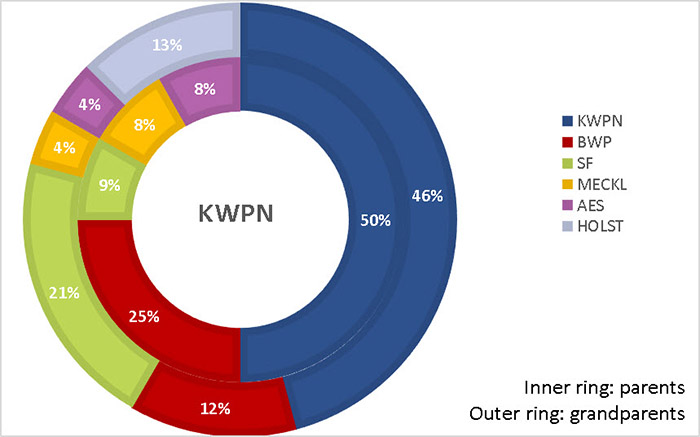
The most represented outside studbook in the top-six horses hailing from the KWPN was BWP, with 25% of parents and 12% of grandparents of these offspring being registered with this studbook. Next came the French with 9% and 21% being branded SF, and them Mecklenburg with 8% and 4% respectively. Parents and grandparents of these horses were also found hailing from the AES studbook, and Holstein.
Next comes the BWP:
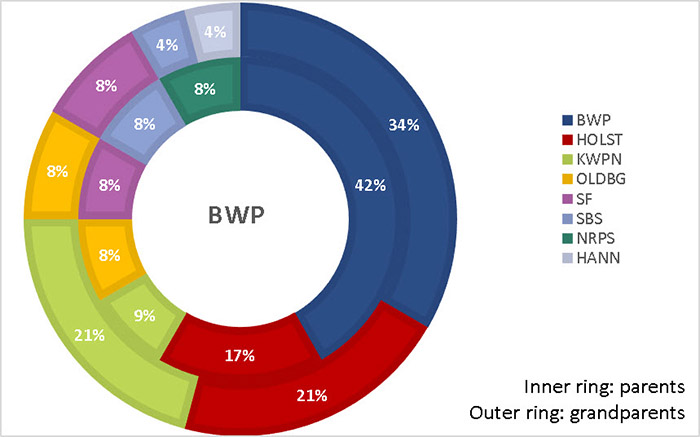
We can immediately see by looking at this chart that this is a studbook that has accepted a fair amount of outside blood. The most influential outside studbook on these horses was the Holsteiners, with 17% of parents and 21% of grandparents from Holstein. Next came the Dutch with 9% and 21% respectively branded KWPN, and then Oldenburg with both 8% of parents and grandparents from this studbook. Other studbooks seen in the first two generations of these top-six representatives of the BWP were Selle Français, sBs, that other Dutch society the NRPS, and Hanover.
And now the Selle Français:
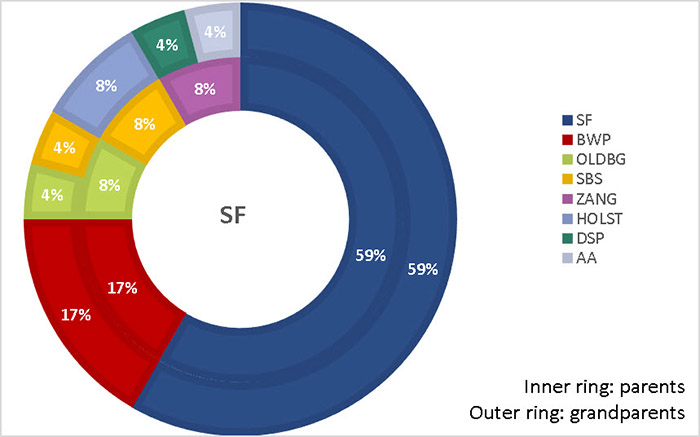
The most represented outside studbook in these pedigrees was found to be the BWP, with 17% of both parents and grandparents of these horses with this brand. Next came Oldenburg and sBs, tied with 8% and 4% of parents and grandparents respectively. Other studbooks found in these first two generations were Zangersheide, Holsteiner, DSP and Anglo Arab.
Thanks Gemma once again, next let’s look at the dressage standings…
The dressage horses
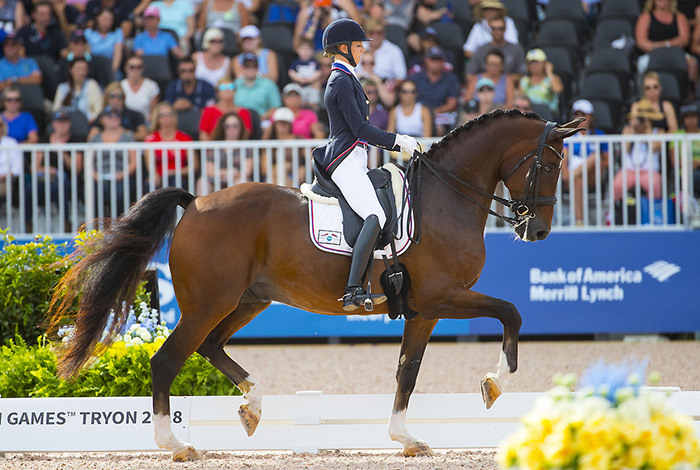
Verdades – world’s number one dressage horse… Photo digi-shots
I am told that the dam of Verdades, the world’s number one dressage horse, has also produced some national level dressage horses, though they don’t show up on the hippomundo data base. Certainly the bloodlines would have most breeders tearing their hair out. Verdades is by the Westfalien, Florett As, a good son of Florestan, who competed at an international Grand Prix level, with Patrik Kittel and Dominic Nathanael Erhart. But the dam, Liwilarda, is the product of an entirely different breeding program, the one that centres around the Dutch Harness horse, and with it, a hefty dose of Hackney blood. I guess the KWPN breeding commission is not planning on introducing Hackney to its dressage population, no matter how successful Verdades is… Still the world’s number one dressage breeder is the late P. Crum of Herveld.
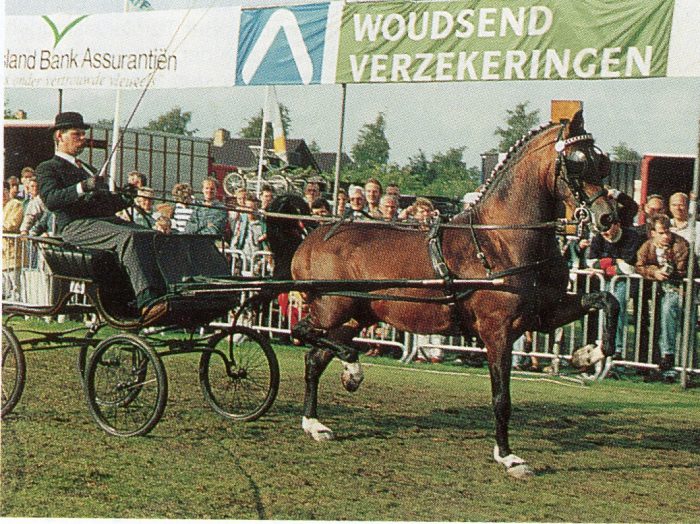
Dutch secret dressage weapon? Hackney stallion Cambridge Cole appears twice on Verdades pedigree… Photo – Jacob Melissen
All the other horses on the top fifty ranking are obviously dressage bred, with the exception of one of the world’s best, the 43rd ranked Cosmo, who is jumping bred – Van Gogh / Frühling.
Once again, veteran German dressage breeder, Inge Bastian, features in second place with Weihegold (Don Schufro / Sandro Hit) but this time there is no doubt in my mind that the Rolex watch(s) should have gone to Westfalien breeders, Heinrich and Wilhelm Strunk, since they produced the third ranked Emilio (by Ehrenpreis out of a mare by the Anglo Arab, Cacir) AND the fourth ranked Bella Rose (Belissimo and out of another daughter of Cacir aa). Both these stars of Isabell Werth’s stable, descend from the founding mare of the family’s breeding program – Pik Dame – by the great Pilatus (who carries on his dam side the invaluable blood of Duellant) out of an Allerhand mare.
Actually, I am informed by the Westfalien Verband’s enormously helpful, Studbook editor, Sarah Schaller that the official breeder of the two horses is ZG Strunk which consists of Wilhelm Strunk, his wife Heike Strunk and his brother Heinrich Strunk. The brothers have been breeding together for a while and added Heike several years ago. The ZG stands for ‘Zuchtgemeinschaft’, which could be translated as ‘breeding alliance’.
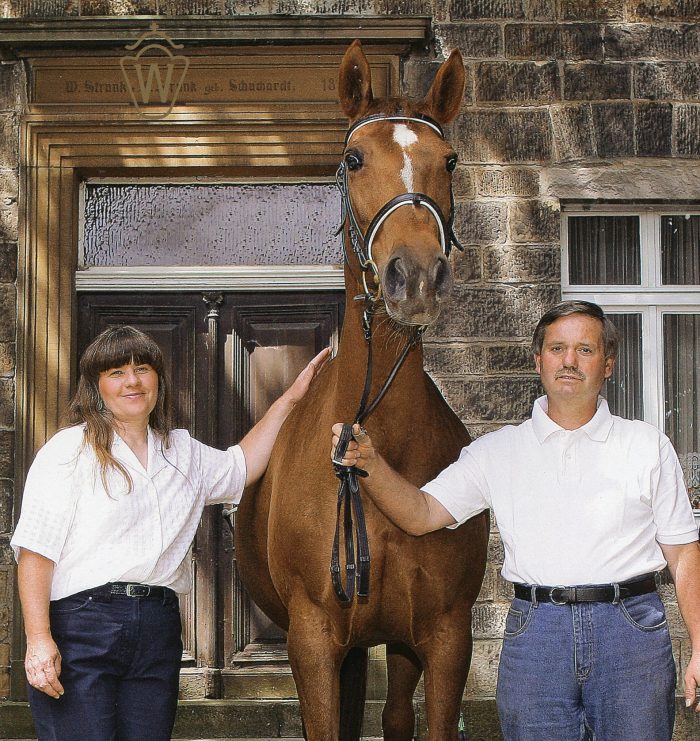
Wilhelm and Heike Strunk
Sarah sent me this examination of the damline of Bella Rose and Emilio which comes from the book, Zucht-schätze – Bedeutende Stutenfamilien in Westfalen by Franz-Josef Neuhaus.
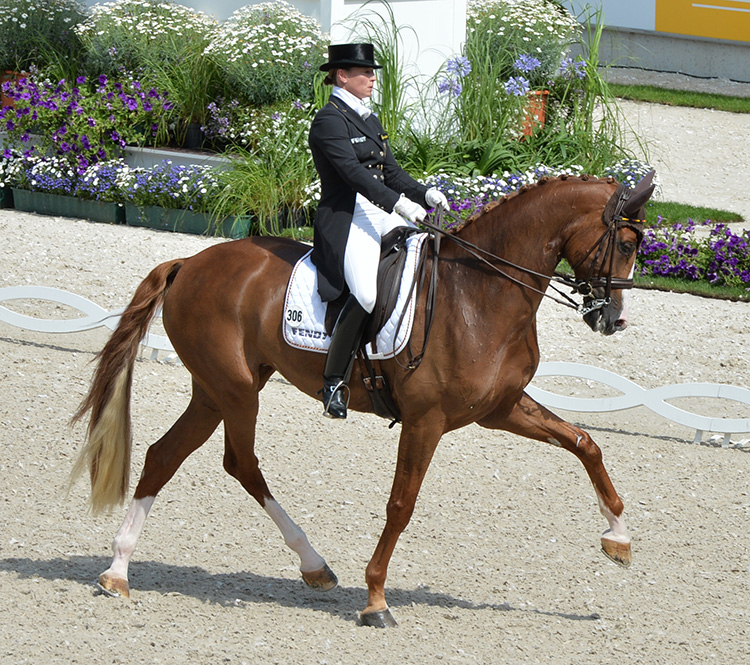
Bella Rose – dressage star
The damline of these two top Westphalian dressage horses originates in the Strunk family’s foundation mare Pik Dame by Pilatus out of Astrid by Allerhand. The Strunk brothers Heinrich and Wilhelm bought this chestnut mare as a three-year-old and she was awarded the State Premium title at the Elite-Show. She stayed with the Strunks for 25 years before she died at age 28 in 1999. Her sire Pilatus is a well-known foundation sire in Westphalia, as he produced not just one but two legendary stallions – Pilot and Polydor.
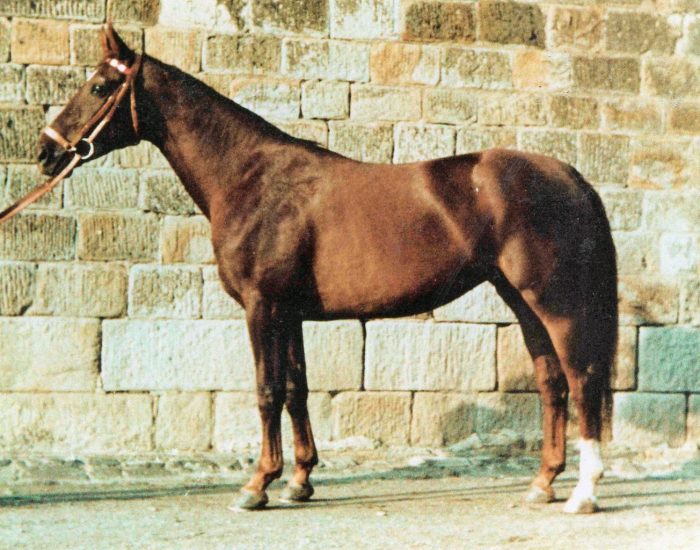
Pik Dame – she founded a dynasty
Pik Dame’s first daughter Comtess by Carrera became a highly influential broodmare at the Strunks’ yard in Bochum. Comtess was covered by the renowned Frühlingsball several times. The pairing produced state stud stallions Francisco I and Francisco II. In between a filly foal of that pedigree was bred and later named Franziska. Franziska is the granddam of Bella Rose. She was covered by the Anglo-Arab Cacir and delivered among others, Bella Rose’s dam Cedra II.
Pik Dame herself was covered by Frühlingsball and produced an exceptional show jumper from this pairing. The chestnut Feiner Kerl was one of Nick Skelton’s top horses in the 80s. The pair won international Grand prix classes. Feiner Kerl’s full-sister Flair remained in the breeding yard of the Strunk family and became the mother to yet another Cacir AA-filly foal, namely Celina. Celina is the dam of Isabell Werth’s second Westphalian in the top ten of the world: Emilio by Ehrenpreis. As well, Celina produced the licensed brothers Fiderglanz I and II.
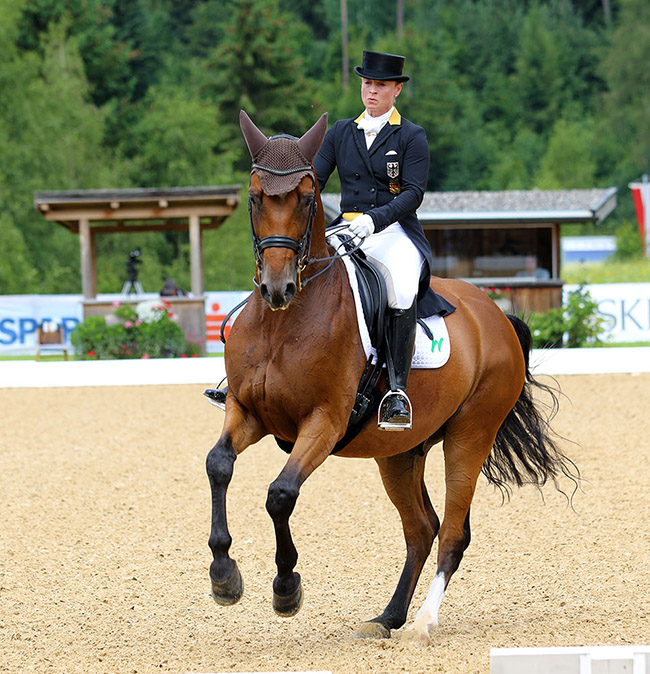
Emilio – old Westfalien lines
Today the Strunks are focussing on dressage breeding only and are operating on a slightly smaller scale than they used to, nevertheless, the qualities of the damline have been established further in the broodmares and the emphasised characteristics like ridability and basic gaits were maintained well. Today the yard keeps thoroughly selected and carefully planned broodmares to maintain this successful damline with the aim of producing further top horses like Bella Rose and Emilio.
I was also intrigued about the dam sire for both – Cacir AA, again Sarah was able to fill the gap…
The Anglo-Arab Cacir originated in France, and was born in 1981. He was moved to the Westphalian/Rhinelandian breeding area, while his older half-brother, the grey Inschallah AA by Israel, was quite influential in Oldenburg breeding, and is well-known for siring Elektia V, mother to Rohdiamant and Royal Diamond.
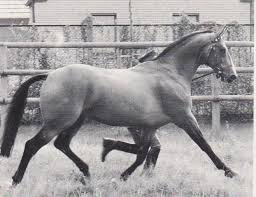
Cacir – Anglo Arab
The dam of Cacir and Inschallah, Resena was a daughter of Nithard out of an Infante dam. Cacir was quite popular during his years at the Gevelsberg station from 1989 to 1996, a local branch of the Northrhine-Westphalian state stud right at the Rhinelandian/Westphalian border. At that time, he covered naturally, so the number of mares he covered was limited. Despite several promising offspring he was sold after standing just a few years. During the time he was available in Gevelsberg the Strunk brothers were convinced of the stallion’s quality. Heinrich Strunk remembers the excellent constitution and fine gaits of the stallion, which he passed to his progeny. The Strunk brothers always focused on ridability in their breeding decisions and with Cacir they found a good match for their mares to pursue their breeding goals further. They brought several mares to Gevelsberg and appreciated Cacir standing at stud there.
Thank you once again, Sarah…
Now to the studbook rankings, headed by the KWPN.
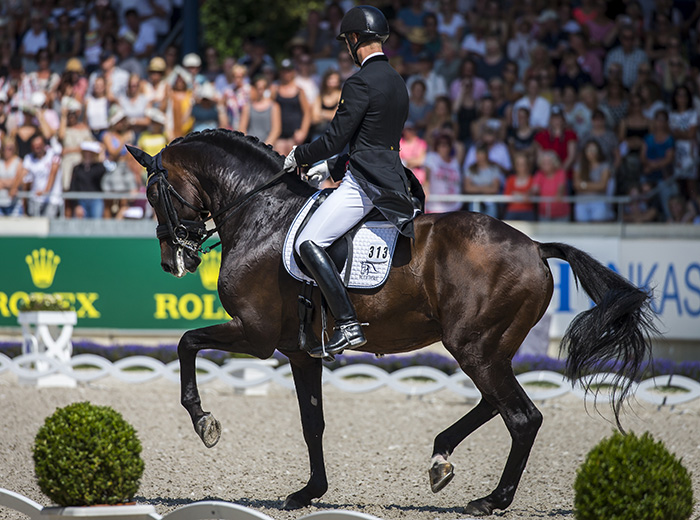
Blue Hors Zack – Dutch dressage lines in action
If we ignore Verdades, the highest ranked dressage horse of Dutch breeding, in 12th spot, is Unee BB, but he is by the German Trakehner, Gribaldi. In 14th we find the first really Dutch representative, Blue Hors Zack, by the Ferro son, Rousseau out of a Jazz mare.
The second placed Hanoverian book, reminds us yet again, of the importance of Donnerhall, and his sons, particularly De Niro, who supplies two of the Hanoverian sextet. The highest ranked Hanoverian, is Charlotte Dujardin’s new star, Freestyle. The bay mare is by the Westfalien stallion, Fidermark (Florestan again), out of a mare by the Oldenberger, Donnerhall.
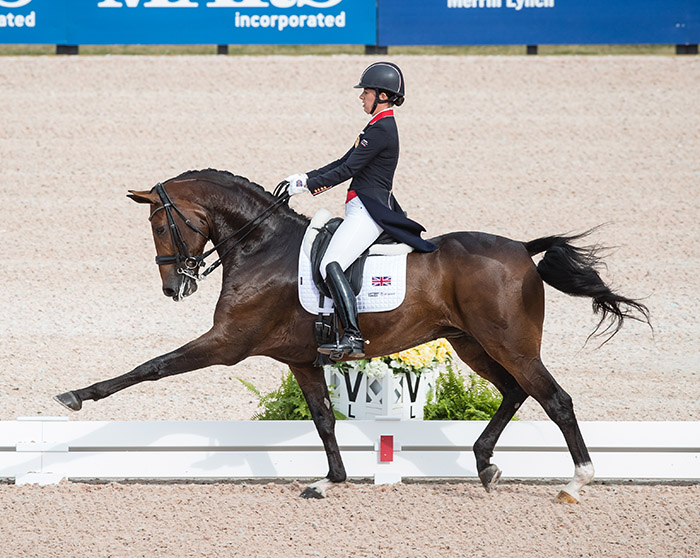
Freestyle – Florestan and Donnerhall – DigiShots Photo
In third place we have the team from Westfalia, headed up by Emilio and Bella Rose, and we can reflect again on the re-emergence of the old Westfalien ‘E’ line, since Emilio is by Ehrenpreis, a son of the great Ehrentusch. This line received a real kick along at last year’s Nürnberger Burg-Pokal, when the stand out star was Escolar by Estobar NRW, another son of Ehrentusch.
The Oldenburg studbook took fourth, with their leading representative, Weihegold, while the Danes were lead into fifth spot by the charming Atterupgaards Cassidy (Caprimond / Donnerhall). Donnerhall, when we talk of dressage breeding we always get back to Donnerhall, and there is no other sire on the horizon who looks like challenging his pre-eminance in the world of dressage breeding.
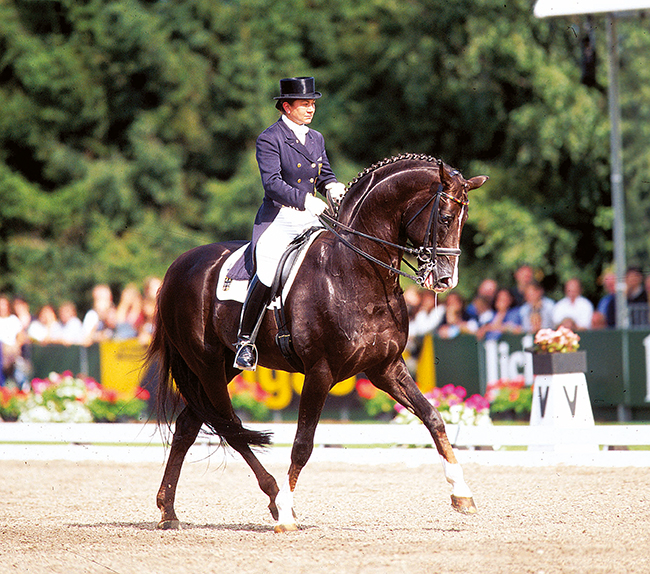
Donnerhall – dressage greatness
Gemma is back:
The dressage top-ten studbooks show the highest incidence of multi-generational registrations; 63% of the top representatives’ parents and 48% of grandparents were also registered with the same studbook as the offspring.
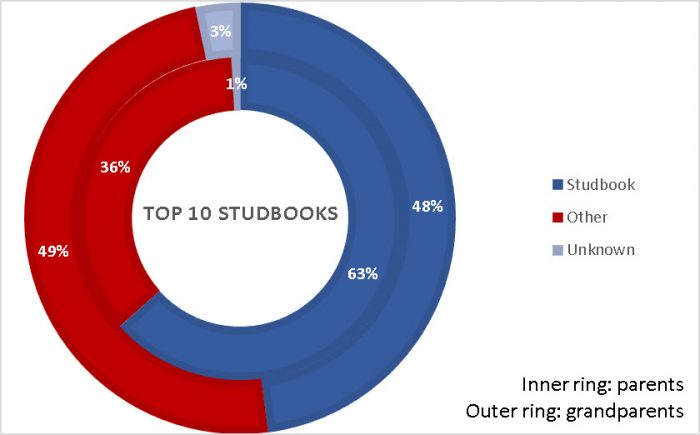
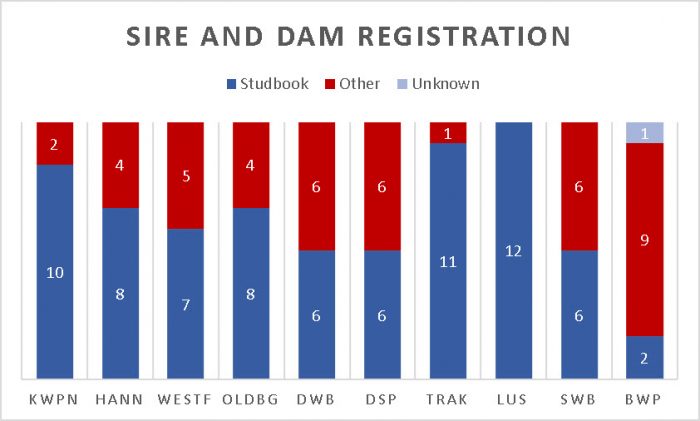
The most ‘liberal’ studbook in the top ten was the 10th placegetter BWP, with just 17% of the top-six representatives’ parents and 4% of their grandparents also being BWP-branded. This Belgian studbook also had the largest number of ‘unknowns’ in the first couple of generations, with one parent and two grandparents of unknown parentage.
The most closed dressage studbook was the Lusitanos – ranked 8th-, with all of the top-six competitors’ parents and 88% of grandparents also registered LUS. Interestingly, despite the apparent closed nature of the studbook, they do not seem to shy away from blanks in the pedigrees; three grandparents of the top six representatives are of unknown origin.
And finally, a closer look at the composition of the top three studbooks: KWPN, Hanoverian and Westfalen.
Starting with the KWPN:
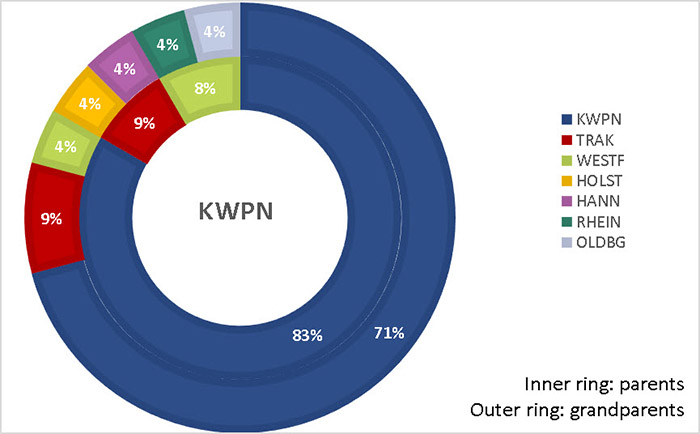
It can immediately be seen that when it comes to the dressage horses, this is quite a closed studbook with the majority of the first two generations also being registered KWPN. The next most represented studbook was the Trakehners with both 9% of parents and grandparents’ registrations. Westfalia had 8% of parents and 4% of grandparents’ registrations, and Holstein, Hanover, Rheinland and Oldenburg all had no parents but 4% of grandparents registered to each studbook.
Next the Hanoverians:
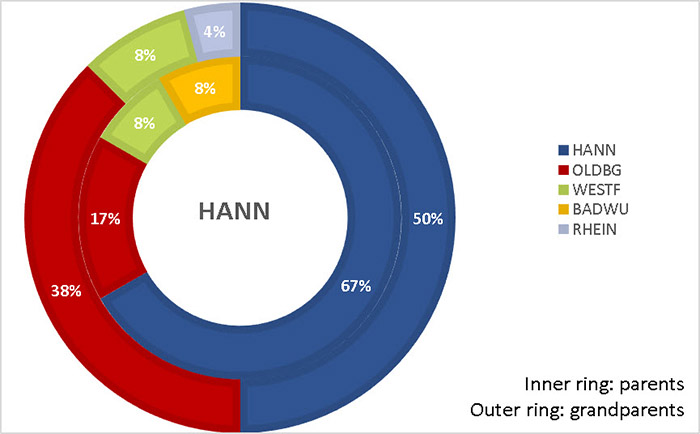
A significant amount of Oldenburg blood is found in the first two generations of these Hanoverians, with 17% of parents and 38% of grandparents from this studbook. The next most represented outside studbook was Westfalia, with both 8% of parents and grandparents. The next most represented was BAD-WÜ, which has now been amalgamated with a number of other studbooks to create the DSP, with 8% of parents registered to this book. The only other outside studbook found in the first two generations of these Hanovarians was Rheinland, with 4% of grandparents.
And last but not least we look at the competitors from Westfalia:
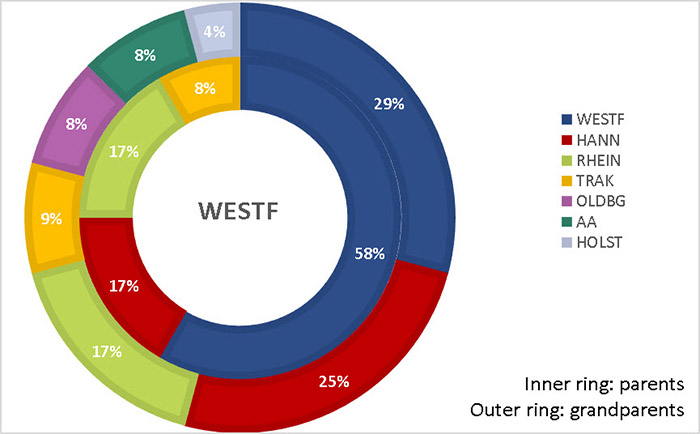
Already at first glance we can see that this is a studbook with quite an open-book policy. The outside studbook having the greatest influence is Hanover, with 17% of parents and 25% of grandparents branded HANN. Next we have Rheinland – which these days is almost seen as a mini-Hanover – with 17% of both parents and grandparents. The third most represented outside studbook was the Trakehners, with 8% and 9% of parents and grandparents respectively registered to the studbook. Other studbooks making an appearance in the first two generations of these horses were Oldenburg, Anglo Arab and Holsteiner.
Once again I thank Gemma for her nifty graphs – I think her analysis has added a whole new dimension to this year’s evaluation of the WBFSH rankings, I hope you found it enlightening too… CH
Looking for these top bloodlines in Australia, here’s a few to choose from from International Horse Breeders, but there’s lots more to choose from, go to: www.ihb.com.au
